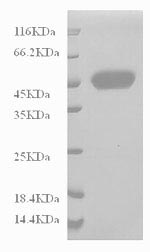This recombinant Human CD14 is a Mammalian cell-expressed protein (Full Length of Mature Protein) with N-terminal 6xHis tag, and it's purified by affinity chromatography method with a purity of 90%+ as determined by SDS-PAGE. Mammalian cell expression system can be used to produce proteins transiently or through stable cell lines, we usually use the transient method for Mammalian cell system protein expression, where the exogenous plasmid is transferred into the cell, and the transcription and translation are directly replicated in the cell. While stable cell lines can be used over several experiments, transient production can generate large amounts of protein in one to two weeks. These transient, high-yield mammalian expression systems utilize suspension cultures and can produce gram-per-liter yields.
CD14 is a glycosylphosphatidylinositol (GPI)-anchored receptor that functions in the TLR4/MD-2 complex to initiate proinflammatory signaling events in response to gram-negative bacteria by recognizing lipopolysaccharide. CD14 has also been shown to be upregulated in tubular epithelial cells of the kidney after unilateral ureteral obstruction and during renal ischemia-reperfusion injury. Stephanie Buchheister et al. revealed that CD14 plays a protective role in inflammatory bowel disease (IBD) development by enhancing intestinal barrier function.






